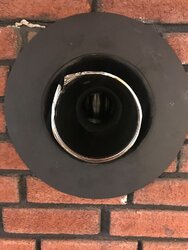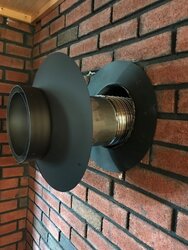Hello, I am installing a new masonry double wall adaptor (for a wood stove) into my new 6 inch chimney liner that is also a double wall or smooth wall liner. As you can see from the pic, there is a 1" or so gap between the new chimney liner and the previous (larger) liner I had before. Once I place my new adaptor, the chimney liner will be suspended with a gap all around it from the adapter till the tee in the back.
Question: Does this gap need to be filled with insulation? should it be filled with insulation or can it be left as it? will insulating it make for a better draft due to the insulation and keeping that horizontal run warmer longer?
Objective: My first objective is safety. Second objective is to have a good draft since I could not insulate the entire liner due to the original clay limiting space availability to insulate the liner with the 1/2 insulation. The original clay was in good condition. My after thought was insulating the liner from the wall adapter inside the home all the way up to the tee.
What is your opinion? thank you for reading and commenting


Question: Does this gap need to be filled with insulation? should it be filled with insulation or can it be left as it? will insulating it make for a better draft due to the insulation and keeping that horizontal run warmer longer?
Objective: My first objective is safety. Second objective is to have a good draft since I could not insulate the entire liner due to the original clay limiting space availability to insulate the liner with the 1/2 insulation. The original clay was in good condition. My after thought was insulating the liner from the wall adapter inside the home all the way up to the tee.
What is your opinion? thank you for reading and commenting


Last edited by a moderator:

